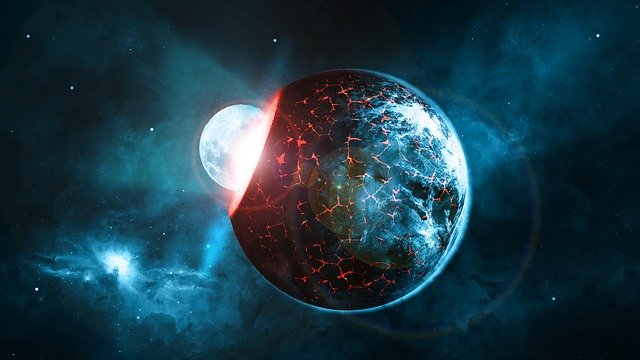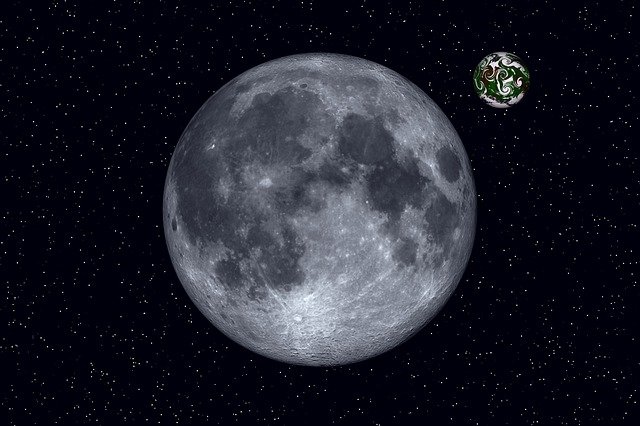*This post may contain affiliate links. This means we may make a commission if you purchase an item using one of our links*
If you’re trying to imagine what would happen if the Earth had two moons, we’re sorry to say that it would probably be bad news for us all. The sudden gravitational pull of the second moon would almost certainly bring about a series of extinction-level events on Earth.
Intrigued yet? You definitely should be, as the idea is absolutely fascinating. With this article, we’re going to cover a few questions you might have about the hypothetical second moon, and to do so, we’ll refer to Neil F. Comins’ writing on this topic.
Comins – a well-regarded physicist and astronomer – had previously toyed around with the idea of an Earth with two moons, and the results of his thought experiment are some of the things we’ll talk about here.
Why Does Earth Only Have One Moon?
Table of Contents

As it stands, we don’t have a conclusive answer to this question. It is entirely possible for an Earth-sized planet to support more than one moon, but it just so happens that we’re stuck with a measly one moon at this time.
Note that we say ‘at this time’. Some scientists believe that there may have been more than one moon orbiting Earth at some point in the planet’s history. Since the Moon itself is so large, though, its gravity might’ve pulled in all the other, smaller moons.
Of course, this also means that Earth might get another moon sometime in the far future. All it would take is a chunkier asteroid that stays in a semi-permanent orbit around Earth. Given enough time – a few thousand to tens of thousands of years – it might even become a permanent fixture!
Is the Earth Too Small for a Second Moon?
There’s no real reason to believe that Earth is too small a planet to support another moon.
What’s interesting, however, is that the Moon of Earth is far larger than any other moon in the Solar system. While most other moons we know about are tiny compared to the planets they orbit, our Moon is as big as one eightieth (1/80) of the total mass of Earth.
Since it’s so big, the Moon affects Earth far more prominently than, say, Io could affect Jupiter. Some even believe that our Moon is directly responsible for the appearance and proliferation of life on Earth.
After all, if there was no Moon, there would have been no high tides to stir things up in the primordial soup.
We have no way of confirming whether this is actually true, but the fact remains that life as we know it would, at the very least, be completely different without the Moon. Or with an extra moon, for that matter.
Would Having 2 Moons Benefit Earth?
According to Comins, and according to what we know about the Moon and its importance, if our planet were to draw in another moon-sized object into a stable orbit, we would be in big trouble in the short-term, and there would be no immediate benefit.
The gravitational pull of the Moon stabilizes the axis of our planet. This is why we have a 24-hour day, why we have a consistent seasonal cycle, and why oceans are spread out the way they are, among a myriad of other things. The Moon’s effects on our daily life cannot be overstated.
Imagine, then, if another Moon-sized satellite was to appear and immediately begin exerting its own gravitational pull on the planet. The results would be catastrophic.
What Would Be the Negatives of Having 2 Moons
The negatives of having two moons would, in the short run, be an apocalyptic rearrangement of everything we know about the planet. Comins said earthquakes and tsunamis would merely be the start, and that mass extinction would be essentially inevitable.
Once the planet settled down into its new axis, Earth would basically begin anew:
- A massive increase in the difference between high and low tides
- Huge changes to how much of Earth is habitable
- Far brighter nights with different day/night cycles
- New adaptations in flora and fauna over long periods of time
Would humanity survive something like this? Statistically, the answer is yes, but it goes without saying that the Earth we all know and love would be gone for good.
Would the Earth Be Able To Sustain 2 Moons if It Did Have Them?

What’s particularly interesting about this thought experiment are its hypothetical long-term consequences.
As you may or may not know, the Moon was originally formed far closer to Earth than it is today. A variety of gravitational interactions (tidal locking being one of the main culprits) had pulled it further away from our planet in the millions of years since, and its current stable orbit cannot be extended further.
What this means is that the theoretical second moon would need to enter the orbit of our planet between the Moon and Earth and stabilize itself somewhere in-between. Otherwise, the Sun’s gravitational pull would simply overpower that of Earth.
From this in-between position, the second moon would start to drift towards the current orbit of the Moon, with them eventually crashing into one another.
Once the two moons collided, Earth would probably once again be left with a single, even larger Moon, and the planet would undergo yet another mass extinction event as debris from the collision entered its atmosphere.
Conclusion: Earth With Two Moons
Thinking about Earth with multiple moons – or Moons, if you will – is a lovely idea, but in reality, the sudden appearance of such a substantially large celestial body in the Solar system would be a grave problem for mankind.
Many scientists do believe that there’s a number of “moons” orbiting Earth at any given moment, but they don’t actually retain a stable orbit, nor are they of sufficient mass for us to even detect them properly.
To conclude, it’s extremely unlikely – albeit logically possible – that Earth will get a second moon during any of our lifetimes. Celestial objects exist and interact with one another on an almost unfathomable scale, and imagination is the only practical way for us to get an Earth with two major moons.
References
Comins, Neil F. What If the Earth Had Two Moons, 2011.

